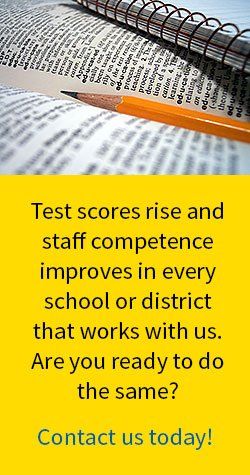Collaborative Observation
When districts have undertaken curricular and instructional reform, it is important to have a system to support teachers as they develop and implement new instructional practices in each classroom. Collaborative networks or peer partnerships are the cornerstone of professionalism. Through these partnerships, teachers form a community of learners who openly and constructively provide each other feedback about classroom instruction. They share a common philosophy about the direct connection between teacher behaviors and student responses.
Furthermore, they believe that professional growth occurs from within and is not imposed from without, despite the authority of the negotiated agreement or principal’s role as evaluator. Teachers work in partnership, observing in each other’s classrooms, implementing collaboratively developed strategies they believe will yield positive results for students.
There is an atmosphere of encouragement and support for each other as new strategies are attempted to improve the quality of teaching. Visiting others’ classrooms decreases the isolation typically felt by many teachers. Talking about instruction from a nonevaluative perspective inspires teachers to honestly and openly think about what they do and how they might do it differently.
The Collaborative Observation process works as a tool to join the reforms of a district with a structure for mutual or shared support during implementation and ongoing revision of these systemic reforms. During the training, school teams experience hands-on activity, conducting conferences with each other and completing observations of actual classrooms. The four key elements of the Collaborative Observation process are:
The Pre-Observation Conference
builds trust through dialogue about instruction between two people. This conference allows the observer to become familiar with the lesson to be observed and to understand what the teacher intends to accomplish. Additionally, they discuss how the lesson to be observed fits into the context of the larger unit. This is a face-to-face conversation between two people for the two to gain an understanding of the thinking and planning that are put into a unit and a lesson.
The In-Class Data Collection and Lesson Analyses are structured formats for collecting key details during the observation of a lesson using scripting of teacher behaviors and students responses. An accompanying analysis is an objective connection between the teachers’ behaviors and their effects on students. Each analysis statement is structured with both elements—teacher behavior and impact on students.
The Post-Observation Conference
is a conversation between the teacher and observer to debrief on the lesson. A specific form is completed by the observer as a planning tool, sketching out what the observer intends to discuss and reinforce in the conference. The observer outlines key details of strength observed in the lesson. In addition, the two conferees identify areas where student responses were not what the teacher had hoped for during the lesson. All comments are stated as a teacher behavior and impact on students.
The Growth Plan is the culmination of the Post-Observation Conference. It is collaboratively developed by the teacher and the observer and sets forth a target area or two for growth, specific strategies to accomplish that growth, and the accompanying criteria for success.
By asking structured questions, the observer prompts the teacher to reflect on his or her teaching behaviors and how students responded during the lesson. Teachers are thus able to identify when the outcomes of the lesson are attained and what practices enabled students to achieve success. Collaboratively, the observer and teacher serve as action researchers, working to determine the most effective way to deliver instruction to the particular group of students in that class.
Ohio Teacher Evaluation System
Collaborative Observation is closely aligned to the OTES to assess the performance of Ohio teachers. It is a resource model to guide districts in the design and implementation of a high quality teacher evaluation system based on state and federal criteria. It defines effective teaching and supports teachers’ professional growth and development.
The components of the model are: 1) Formal Observation Process; 2) Professional Goal-Setting Process (may include Professional Project); 3) Student Growth and Performance Data; and 4) Communication and Professionalism. The Summative Evaluation process includes rubrics for the components and an overall teacher effectiveness rating.
Close Your School’s Student Mastery Gap
Take the Self-Assessment
- All Ohio school districts are required to provide instruction so students can pass the Ohio State Tests (OST).
- When students fail to pass the OST tests, it reflects negatively on the school and the district as a whole.
Schedule a Consultation
- The EdFOCUS materials are written exclusively to the Ohio Standards and address the underlying level of thinking required for mastery.
- EdFOCUS materials are directly connected to the standards.
Improve Outcomes
- Classroom instruction is made more effective.
- District OST scores reflect mastery of content standards which generates public support and increases the state ranking.
Test scores rise and staff competence improves in every school or district that works with EdFOCUS.
Is your district ready to improve?
Contact Us
Is your school or district ready to improve student achievement?
Contact the EdFOCUS team today at (330) 842-0742.
©2023 EdFOCUS Initiative | Site Map | Privacy Policy | Accessibility

